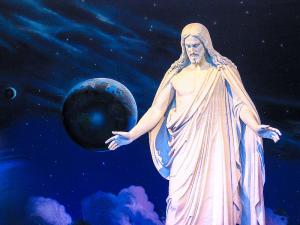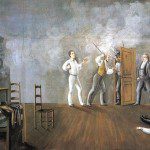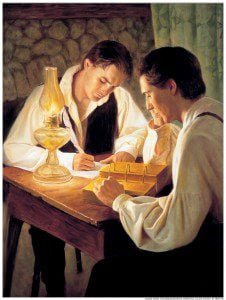The Community of Christ’s April 2013 USA National Conference in Independence, Missouri resoundingly approved the extension of the sacrament of marriage to same-sex couples and the ordination of individuals in monogamous same-sex relationships. That the Community of Christ, Mormonism’s most progressive denomination, has approved these measures through a democratic conference is perhaps unsurprising. Community of Christ laity and leaders are fond of saying that they are called to be a “prophetic people” rather than “a people with a prophet.” However, as a delegate to the USA conference, I observed that one prophet was very much present among the people. And that prophet was Joseph Smith, Jr.
Take for instance the worship setting during the conference. In a choir loft to the left of the conference chamber’s immense organ, worship planners constructed a simulated grove of aspen trees. Priesthood leaders made constant reference to this grove during worship moments interspersed throughout the conference. Listen to this statement that was part of a worship service on Saturday night at the conference:
We gather for worship today in a grove of aspen. Aspen trees only grow in community; they cannot grow alone. Though they appear to be separate trees, they are connected by their roots and in fact an entire grove of aspen trees, though they appear many, is really one organism, one body. Their deep roots give them the strength to weather difficult times and to reach the full potential that the Creator intended. Connected this way, aspen groves endure for many thousands of years. And so, we find ourselves here in the grove the place where we gather together to discover God’s will for the church. We have been here before, and know that God is faithful and will meet us here again. We know that every encounter with God, every touch of the Savior, every dance with the Holy Spirit leads us into the unfamiliar future. God will meet us there, too, as we are being rooted and grounded in love. [1]
Where is Joseph Smith in this reading? He’s in the aspen grove. Look closely. “We have been here before,” says the worship leader. As Mormons of all groups well know, in the spring of 1820 (give or take a few years), Joseph Smith claimed to have encountered Jesus while he knelt in prayer in a grove of trees on his family’s farm near Palmyra, New York. Smith had gone to the grove out of distress over pressing questions in his life—questions dealing with the welfare of his soul and the doctrines of various Protestant churches in his area. [2] In the scene painted by the worship leader, the Community of Christ’s collective experience at the conference can be read as an echo, a recapitulation, a restoration of Smith’s experience. Joseph was a spiritual seeker needing guidance and assurance, and we are spiritual seekers facing a similar dilemma, suggests the worship leader. And Joseph’s seeking process—significantly not his answers—becomes the model for our search in this moment.
Joseph Smith the Seeker accords well with the sources of spiritual authority upheld by many Community of Christ members. When 76% and 81% of the conference delegates voted for same-sex marriage and GLBT ordination respectively, the majority cited as their rationale that they did so because “study, prayer, and the promptings of the Holy Spirit have led me to this perspective.” [3] This response may seem divorced from any reference to Smith. However, the delegates’ rationale implicitly invoked Smith’s example. During sessions where delegates shared their views on same-sex marriage, I heard several delegates who were pro-GLBT make reference to Joseph Smith, and, every time, they referred to his process of spiritual seeking. Sometimes they even referenced the 1832 version of Smith’s vision (the earliest written account), a gesture toward the cultural capital that these delegates held as readers of post-1960s scholarship on early Mormonism. Again, the content of Smith’s vision was not as important to these contemporary seekers as was how they positioned themselves as aligned with Smith’s process.
Beyond the worship settings and stories shared by delegates at the USA Conference, the image of Joseph the Seeker is pervasive in contemporary Community of Christ literature. Open up the newest issue of the Community of Christ’s Herald (the official denominational magazine). Three references in the May issue refer to Joseph Smith’s 1820 experience in the grove, one going so far as to say, “Like the young boy in the grove, members of our faith community are encouraged to ask life’s difficult questions, explore the scriptures for divine guidance, and to go to the Lord in prayer.” In all of these constructions, Joseph is not Joseph the Martyr or Joseph the Seer or Joseph the Best-Dad-Ever (the most popular contemporary LDS constructions, as nearly as I can tell), but he is a perplexed, earnest spiritual traveler. Clearly, Community of Christ leaders, as well as members, are constructing a usable Joseph Smith for their present. [4]
Religious studies scholar Robert Orsi suggests that “religious worlds. . . offer practitioners opportunities to form deep ties with saints, ancestors, demons, gods, ghosts, and other special beings, in whose company humans work on the world and on themselves.” Like relationships between humans, religious relationships carry with them manifold ambiguities and complexities, too. [5] We should not be surprised that the members of the Community of Christ have navigated new changes in their denomination—“working on the[ir] world”—at least in part through their complicated relationship with an ancestor. In a time of transition, Joseph the Seeker shares his grove with them and all who search.
[1] This text, used in a conference worship service, may be found as part of worship reflection activity for congregations after the conference. See “Welcome to the Grove.” http://www.cofchrist.org/
[2] Davidson, Whittaker, Ashurst-McGee, and Jensen, eds., Joseph Smith Papers, Histories, vol. 1, Joseph Smith Histories, 1832-1844 (Salt Lake City: Church Historian’s Press, 2012), 11-13.
[3] Rather conveniently for my sake, the delegates took a real-time poll directly after voting with ten choices to explain their rationale for and against the issues. The choices had been generated by responses that church officials had heard over and over again in conversations with congregations over the last three years in preparation for the conference.
[4] Barbara Walden and Lachlan Mackay, “Develop Disciples to Serve,” Herald 160.5 (May 2013): 10.
[5] Robert A. Orsi, Between Heaven and Earth: The Religious Worlds People Make and the Scholars Who Study Them (Princeton: Princeton University Press, 2005), 2.











